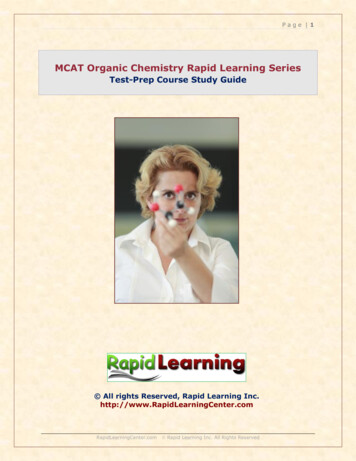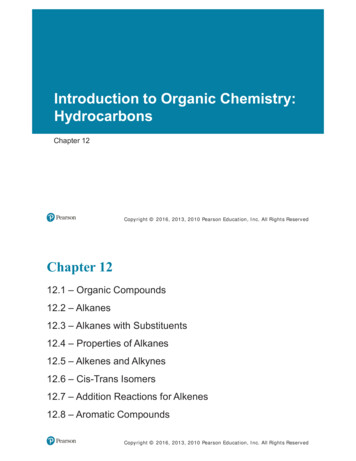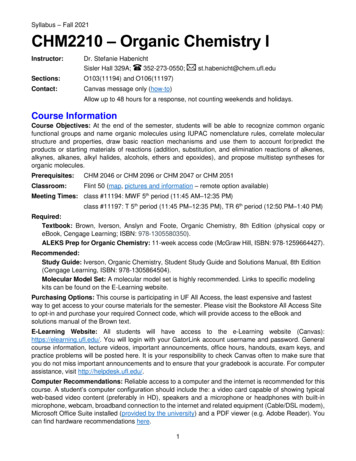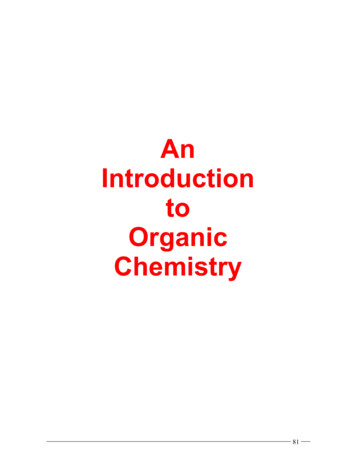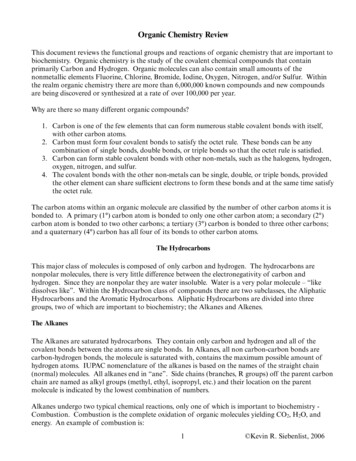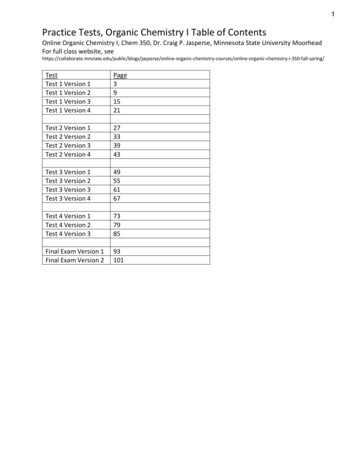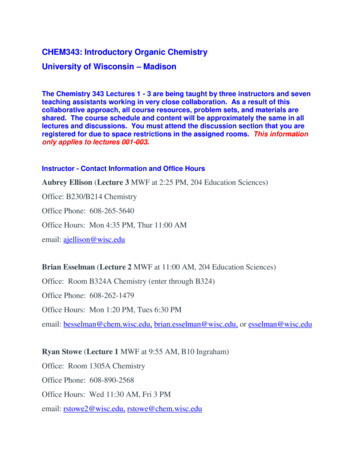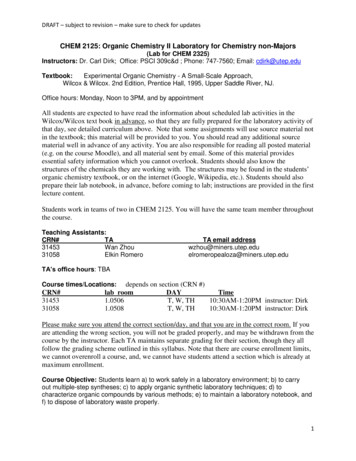
Transcription
Instructor: Matthias Brewer; Office: Cook A316; email: Matthias.Brewer@uvm.eduBlackBoard Site: bb.uvm.eduLecture: 10:40am – 11:30am MWF, Angell B106Review Sessions: 5:30pm Thur., Angell B106Laboratory Check-in is week of Jan 26th.Required text and course materials:Organic Chemistry 2nd ed., David Klein, Wiley (ISBN: 978-1-118-45228-8)Access to WileyPLUS: (URL: /)Organic Chemistry Study Guide by David KleinChem. 142 Laboratory Manual (available from 1st floor stockroom, Cook A143)Bound lab notebook with numbered pages (can continue to use that purchased for 141).Safety glasses (available in the UVM Bookstore)Useful materials on reserve in the library:Organic Chemistry I as a Second Language: Translating the Basic Concepts 2nd ed., D.Klein; ISBN: (978-0470-12929-6)Organic Chemistry II as a Second Language: Second Semester Topics 2nd ed., D. Klein;ISBN: (978-0-471-73808-4)Other books in library that you may find useful:The Art of Writing Reasonable Organic Reaction Mechanisms R.B. Grossman; ISBN:0387-95468-6Writing Reaction Mechanisms in Organic Chemistry A. Miller; ISBN: 0-12-496711-6Course Prerequisite: Chemistry 141 or 143.Office hours:Mon. 2:00-3:00 pmThur. 10:00-11:00 amTA Office hours are arranged according to lab section.If you can’t attend office hours, or you need to see the instructorsor TAs outside office hours, please make an appointment. Email isthe best way to get a quick answer to a question.
Chem. 142Brewer, M.General CommentsIn Chemistry 142 we continue to explore the basic principles of OrganicChemistry with a greater emphasis on the chemical reactivity of various functional groups(i.e. more similar to the last 1/3 of the first semester course). You will also learn about theanalytical instrumentation used on a daily basis by chemists to determine the structureand composition of molecules.By now you have probably noticed that Organic Chemistry involves many newconcepts, a large number of rules and a very large number of reaction mechanisms.However, as the course progresses and your organic “repertoire” grows, you will also findthat a relatively small subset of rules serves to tie together the vast amount of informationcontained in the text. A special effort made at the beginning of the course to review andmaster important concepts from the first semester will pay off as the course progresses.Topics that are especially important to review include:Arrow Pushing (Chapter 3): Arrow pushing may be the most important “tool” of organicchemistry because it allows you to show a pictorial representation of a reactionmechanism. When done properly, arrow pushing will allow you to keep track of thebonds that are made and broken throughout the course of a reaction, as well as keep trackof any formal charges that develop. Having a good grasp of arrow pushing will makelearning the large number of reactions you will see in this course easier because you willthen understand the underlying mechanism of the reaction rather than trying to memorizeeach reaction as an independent “fact”. I can’t overemphasize the importance of havinga good working knowledge of arrow pushing. Be forewarned that arrow pushing will beused on a daily basis in class and you will be expected to write mechanisms using correctarrow pushing on exams.Resonance (Chapter 2): This is a very important concept and you have already seen thatresonance can help rationalize why carboxylic acids are acidic and alcohols are not. Youwill see resonance used over an over again to rationalize why molecules react the waythey do, and a good understanding of the rules for writing proper contributing “structures”to resonance hybrids will make the understanding of reaction mechanisms considerablyeasier. In order to have a good understanding of resonance you must also have a goodgrasp of electronegativity and arrow pushing.Electronegativity: An understanding of the relative electronegativity of atoms is essentialto understanding why molecules react the way they do. For example, the concept ofelectronegativity allows you to rationalize why some atoms are good leaving groups andothers are not.Chemical Reactions: You will be expected to know all the chemical reactions youcovered in Chem. 141.Nomenclature: Particularly, the names of all the functional groups as well as the standardIUPAC rules for naming simple organic compounds. If you don’t know the functionalgroups, you will not be able to follow the discussion in class.Stereochemistry: Determining R/S designations as well as E/Z. Understanding thedifference between different types of stereoisomers (enantiomers/diastereomers) andPage 2 of 7
Chem. 142Brewer, M.being able to correctly identify the stereochemical relationship between compounds (i.e.are they diastereomers, enantiomers, constitutional isomers, different molecules, etc.).Key’s to success in Organic Chemistry: Do not try to cram! Work as many practice problems as possible. Solving problems reinforces the newconcepts and is the only way to test your understanding of the material. You will see many new concepts in this course. Try to write out an explanation ofthe concepts in your own words as if explaining them to someone else. Do not look at a problem’s answer until you have really tried the problem. Afterseeing the answer it often seems obvious and you may assume you understand. When you get a problem wrong try to understand where your thinking was in errorand attempt to identify what concept you missed. Ask questions! Come to review sessions, office hours or make an appointmentwith me or your T.A. to resolve any questions early! Review the material frequently. Many people find that flash cards are a good way to learn this material.For each chapter you should work as many of the suggested problems as possible.I strongly urge you to keep up with your reading and problem solving. Learning organicchemistry takes a combination of patience, practice, and repetition. Cramming does notwork well in this subject!Academic Conduct: Cheating will be considered grounds for failing the course. Allgraded assignments in the lecture and the laboratory must be your own work. Cases ofcheating or plagiarism will lead to further disciplinary action which may include dismissalfrom the University according to the rules set forth in The University of Vermont’s Codeof Academic Integrity.Policy of Electronic Device Usage on Exams: In short, you can’t use them! The use ofany electronic device (calculator, cell phone, ipod, or anything else with batteries or asolar cell) is strictly forbidden on exams and will be considered cheating.Grading: 3 mid-terms 55%; Final exam 20%; Lab grade 20%; On-line problemsets 5% The course grade will be based on three mid-term exams, a compulsorycumulative final exam, a laboratory grade and on-line problem sets. The final exam scorecan be used to replace one mid-term exam score if the final exam score is higher. Finalexam grades will not be dropped. Two alternative exam times will be offered for eachmidterm exam; these will occur before the actual exam time. No makeup exams will beoffered; if you miss an exam for any reason, you will receive a grade of zero for thatexam (this zero can count as your lowest exam grade that is substituted by the final examscore). A request to take the exam at one of the alternative times including a legitimatereason for the request must be made in writing by the Friday before the normal examPage 3 of 7
Chem. 142Brewer, M.time. No curves will be applied to mid-term exams. Please note that you must earn apassing grade in the laboratory to receive a passing grade for the course. More thantwo laboratories missed for any reason will result in a failing grade for the course(unless you are granted an incomplete by your Dean).Exam Re-grades: If you have any questions concerning the grading of an exam, youmust see me within one week after the day the exam is returned to the class.Midterm Dates:Thursday, February 12Thursday, March 19Thursday, April 165:30 P.M.-7:30 P.M.5:30 P.M.-7:30 P.M.5:30 P.M.-7:30 P.M.Where to take your exams: Due to class size, the midterms will be held in two separaterooms as follows:Last Name A-N will take exams in Angell B106Last Name O-Z will take exams in Angell B112Final Exam Date:Monday, May 4th7:30 A.M.-10:15 A.M.Place: TBAProblem Sets:WileyPLUS will be used to assign graded problem sets. Each student will receive arandomized subset of problems from a larger pool. These problem sets will becomeavailable Thursday night after the review session and must be completed by midnight thefollowing Monday. All problems from the pool will become available after the due dateand these problems will serve as a basis for the subsequent Thursday night reviewsession. No problem sets will be assigned the week preceding an exam.This course will address learning goals 1,2,3, and 5 below for chemistry majors:1. Students will demonstrate general knowledge in chemistry and will be able toapply chemical and physical principles in the solution of qualitative andquantitative chemical problems.2. Students will understand the interplay of observational data, hypotheses, andhypothesis-driven experimentation through application of the scientific method.3. Students will become proficient in chemical laboratory techniques and be able toapply these to practical and current problems in research.4. Students will be able to read and critically evaluate the chemical and scientificliterature.5. The students will learn to present scientific data clearly and effectively throughboth written and verbal communication.Religious Holidays: Students have the right to practice the religion of their choice. Eachsemester students should submit in writing to their instructors by the end of the secondfull week of classes their documented religious holiday schedule for the semester. Facultymust permit students who miss work for the purpose of religious observance to make upthis work.Page 4 of 7
Chem. 142Brewer, M.Tentative Outline of CourseChapter 15. Infrared Spectroscopy and Mass SpectrometryChapter 16. Nuclear Magnetic Resonance SpectroscopyChapter 12. SynthesisChapter 13. Alcohols and PhenolsChapter 14. Ethers and Epoxides; Thiols and SulfidesChapter 11. Radical ReactionsChapter 17. Conjugated Pi Systems and Pericyclic ReactionsChapter 18. Aromatic CompoundsChapter 19. Aromatic Substitution ReactionsChapter 20. Aldehydes and KetonesChapter 21. Carboxylic Acids and Their DerivativesChapter 22. Alpha Carbon Chemistry: Enols and EnolatesChapter 23. AminesConcepts you must understand from General Chemistry: Properties of covalent bonds The octet rule Structural isomers Lewis dot structures Formal charges Resonance Electronegativity and bond polarity VSEPR (Valence Shell Electron Pair Repulsion) HybridizationPage 5 of 7
Chem. 142Brewer, M.Chem 142 2015 Lab ScheduleDateExpt #1/26-1/29TitlePageCheck-in2/2-2/51Reduction of Vanillin92/9-2/122Oxidation122/16-2/192/23-2/26NO LAB3/43/5-3/83/9-3/12Generation and reaction of an organometalliccompound Part 115NO LAB/ SPRING RECESS3/4Generation and reaction of an organometalliccompound Part 2153/16-3/195Diels-Alder183/23-3/266Nitration of Methyl Benzoate213/30-4/27The Wittig Reaction244/6-4/98Production of Biodiesel274/13-4/169Synthesis of Aspirin294/20-4/2310Solventless Aldol and Check-Out31Page 6 of 7
Chem. 142Brewer, M.On-line resources that may be useful to youhttp://www.wiley.com/college/kleinNavigate to the Student Companion Sitehttp://www.chemtube3d.com/Main%20Page.htmlHigh quality videos of organic reaction mechanisms.http://ochem.jsd.claremont.edu/On-line flash cardsVideo TutorialsPractice ProblemsPage 7 of 7
Organic Chemistry Study Guide by David Klein Chem. 142 Laboratory Manual (available from 1st floor stockroom, . use that purchased for 141). Safety glasses (available in the UVM Bookstore) Useful materials on reserve in the library: Organic Chemistry I as a Second Language: Translating the Basic Concepts 2nd ed., D. Klein; ISBN: (978-0470 .

